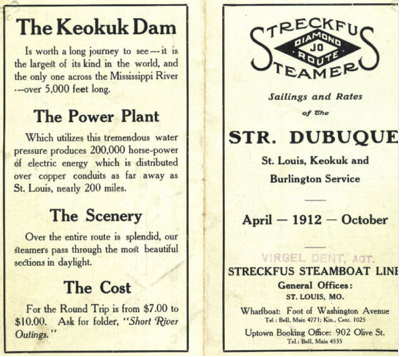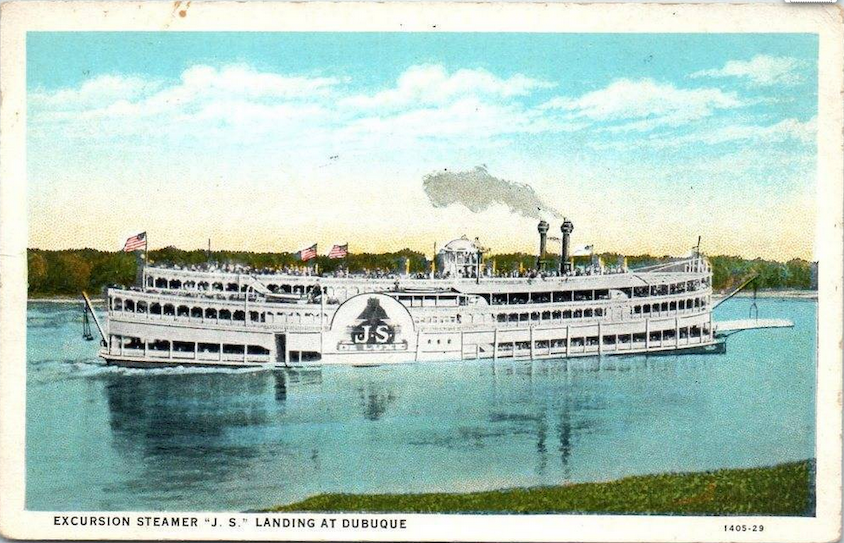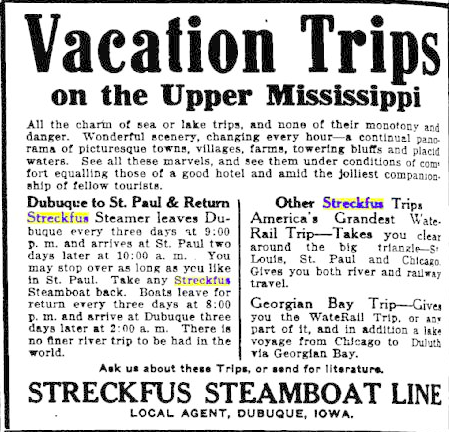Encyclopedia Dubuque
"Encyclopedia Dubuque is the online authority for all things Dubuque, written by the people who know the city best.”
Marshall Cohen—researcher and producer, CNN
Affiliated with the Local History Network of the State Historical Society of Iowa, and the Iowa Museum Association.
STRECKFUS STEAMBOAT LINE
STRECKFUS STEAMBOAT LINE. In 1884 Captain John Streckfus, Sr. established the Acme Packet Company. Located in Rock Island, Illinois, the company had a small fleet of packet boats used for shipping freight and passengers along the MISSISSIPPI RIVER from Rock Island to Clinton. He pioneered that trade and later added the city of Winona, Minnesota to his routes. (1)
Streckfus bought his first steamboat in 1889 for $10,000. Verne Swain, a small steamer, measuring just 120-feet in length and 22-feet in width, was constructed in Stillwater, Minnesota at the Swain Shipyard. Verne Swain operated daily during the boating seasons with several stops between Davenport and Clinton Iowa making a three-hour, one-way trip. The boat then left Clinton in the afternoon and returned to Davenport every evening. (2)
By 1891, Streckfus had acquired his own operator’s license and the title of Captain. Previously he contracted for established operators to manage his steamers and later he earned an engineer’s license. The same year, he bought his second steamboat, the Freddie, a triple-decked, 73-foot sternwheeler with a 16-foot beam. He transported freight and passengers on both the Mississippi and the Ohio rivers, though eventually, he ran his packets on the Mississippi, north of St. Louis. Though he gained a reputation for punctuality and efficiency, he complained about the small profits his packets earned. (3)
By 1901 rather than using his slow paddle-wheelers to compete with the railroads for the freight business, he transitioned to the excursion business and installed a calliope on the City of Winona which when played carried news of the ship's arrival for many miles. The next year he increased his investment in the new venture with $25,000 in capital to convert a packet. Using his own design, Streckfus commissioned work on a 175-foot steamboat with a capacity to hold 2,000 passengers, sleeping berths for the crew and the entertainers, a 100 x 27 foot maple dance floor, bar, dining room, and electric lights. His first custom-built excursion boat was named the J.S. (4)
By the turn of the century, Streckfus recognized the impact of railroads on the shipping trade. To reduce losses, he reorganized his company. In 1907, he incorporated Streckfus Steamers to raise capital and expand his riverboat excursion business. He maintained a few packet boats but began operating an overnight passenger trade before converting the ships into excursion boats. (5) Streckfus was also an innovator. The first system of incandescent and arc lighting whose current was generated from one dynamo was installed on his "Verne Swain." The "J. S." carried the first soda water fountain, telephone system, and running water.
A unique characteristic of the Streckfus Fleet was the fact that each of the steamers was designed and built for one-day pleasure outings, bringing the joys and thrills of a steamer ride on the river within the reach of nearly everyone. Even on the S. S. President, newest and mightiest of inland passenger steamers, a ticket for an all-day or evening outing cost only a few cents more than the average movie admission. On most of the other vessels, the fare is even lower. The Streckfus organization, by applying the principle of mass handling, made available the luxury of ocean liner service on the inland waterways to everyone who had even a very little money to spend for pleasure and recreation. (6)
Moving freight on steamboats had been a dying business for a few decades which made many steamboat owners motivated to sell. At the time an article in the Dubuque Telegraph-Herald commented:
... the trade interests of St. Louis and the valley of the upper river
will welcome the sale of the Diamond Jo. The present management, while
conservative, and paying much attention to safety of passengers and
upkeep of property, has been satisfied with operating during a very
short season and confined its energies mainly to passenger trade
carried on in the old way...when the passengers' excursion season came
to an end with the reopening of the public schools in September, the
Diamond Jo boats have been content to seek the berths in the inner
harbor at Dubuque, there to await the business of the next spring. (7)
John Streckfus used capital raised by Streckfus Steamers to purchase on February 3, 1911 the DIAMOND JO LINE. This included the Dubuque and three damaged riverboats: Sidney, a 221-foot sternwheeler; St. Paul, a 300-foot side-wheeler; and another side-wheeler, the 264-foot Quincy. Streckfus Steamers paid $200,000 for all of these ships and land-based assets. According to reports at the time neither the St. Paul nor Quincy could be duplicated for less than $85,000. The deal also included fifteen landing places, valuable terminal property in Rock Island and Dubuque, and a wharf leased for twenty-five years in St. Paul at five dollars annually. (8) When he visited Dubuque in June, 1911 it was noted that Captain Streckfus did not say anything about making the ICE HARBOR as a winter port. (9) Streckfus did not believe in "berths in the inner harbor" it came to be understood. His boats were used year round.
The Streckfus Company announced that it intended to remodel the Sidney into a first class excursion boat to take the place of the J. S. which was destroyed by fire near Victory, Wisconsin on June 18, 1910. (10) The Sidney was to be ready for the excursion season beginning on May 1st. As the renamed J. S. "Deluxe, it operated between Peoria and St. Paul during the summer and south at New Orleans during the winter. (11)
The economic success of the excursion business seemed assured from the beginning. In 1911 the Dubuque Telegraph-Herald reported that the excursion boats W.W. and Sidney "wee taxed to their wonderful capacity by thousands of excursionists." The article continued "the big boats have been chartered until late in the fall by the heavy demand for their services." (12)
In 1915 the W. W. began receiving negative publicity. In trips along the MISSISSIPPI RIVER it was claimed that the boat needed a barge along side it because it was top-heavy. Potential passengers would not ride on it for fear of it capsizing. The boat was scheduled for the standard test. In this, bags of sand each representing the weight of a single person were placed on the boat. As soon as the capacity of the boat was reached, the vessel was moved to the center of the river and all the bags were moved to one side to determine the maximum amount the boat listed to that side. (13)
The fire that destroyed the J.S. had a profound effect on Streckfus. For the rest of his life, Streckfus had the desire to build or purchase a steel-hulled vessel because the potential for a fire would be less. In addition, the US Coast Guard had developed stricter standards for wooden hulled riverboats. Having a steel-hulled excursion riverboat would not happen within his lifetime as he passed away in 1925. (14) The Streckfus Line's first all-steel, air-conditioned liner was the President which was built in St. Louis in 1936 at a cost estimated to be $1 million. (15)
John Streckus chose for his first conversion the largest of the Diamond Jo steamers, the 300-foot St. Paul. The company ran the first excursion for the St. Paul in 1917, and the next year it traveled between St. Louis and its namesake city on the Mississippi. The cabin was fitted with electric lights and fans. In its third season, the steamer ran aground on a sandbar. During the 1920s, Streckfus positioned it further south, between the Quad Cities and Cape Girardeau, Missouri. The next decade, the large steamer provided service along the Ohio River until 1930 when it was rebuild. Rechristened Senator, it ran excursions for just a few more years. While general offices of the new company remained in St. Louis, it was announced that Dubuque would remain important since it was a midway point between there and St. Paul. (16)
A sharp increase in business in 1919 was attributed by Streckfus officials to PROHIBITION and the saving of liquor money for other recreational activities. (17) The same year, Streckfus Steamers carried out the second conversion from their Diamond Jo fleet, the Quincy. As the J.S. Deluxe the ship catered to wealthy people from St. Louis until the President took over in 1934. (18)
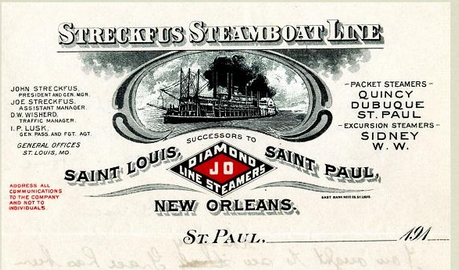
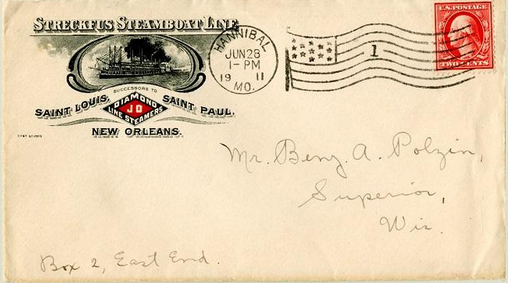
The old sternwheeler, Dubuque, became the Capitol. Not requiring as much water depth as other ships in their fleet, Streckfus put it into use in the Upper Mississippi, while it served local cruises at New Orleans in the winter. Fate Marable performed on the Capitol starting in 1920, leading a band including Louis Armstrong, Boyd Adkins, Norman Brashear, Warren “Baby” Dodds, David Jones, Henry Kimball, and Johnny St. Cyr. (19)
As another consequence of the Streckfus Steamboat Line purchase, the people of Dubuque were introduced to New Orleans JAZZ with the music of Louis Armstrong who went on to musical greatness and international recognition. Musicians on Streckfus Steamers were not given star status. John Streckfus' policy of standard wages offered band members $35 per week, plus room and board (or $65 per week without room and board). In 1919 he lowered compensation in 1919 to $37.50 per week—non-inclusive of room and board—- with much shorter work schedules. Seven years later, the company increased pay to $45 per week and added $5 weekly retention bonuses, without room and board. A few exceptional musicians, like Armstrong, were allowed to improvise a little on the music they played. The Streckfus family otherwise insisted that the performers play the arrangements as written. This encouraged gifted musicians like Armstrong to advance his career elsewhere. (20)
The Capitol, the largest sternwheel passenger steamer on the Mississippi, visited Dubuque in 1936. The excursions that day were sponsored by DUBUQUE SENIOR HIGH SCHOOL, St. Mary's Sodality and ST. MARY'S CATHOLIC CHURCH, and IMMACULATE CONCEPTION ACADEMY alumnae. The high school excursion left Dubuque at 10:00 a.m. and returned at 6:30 p.m. The St. Mary's Sodality and Immaculate Conception Academy left Dubuque at 8:30 p.m. (21) The Capitol visited to Dubuque in September, 1937 en route to its fall and winter seasons in New Orleans. (22) In 1942, undoubtedly due to decreased business and rationing during WORLD WAR II, President was the only member of the Streckfus fleet to operate on the Upper Mississippi River. It visited Dubuque on June 25th. (23)
The SS Admiral was the first of the Streckfus fleet to be built with a metal superstructure on a steel hull. Originally the 1907 Albatross, a railroad ferry, built by the DUBUQUE BOAT AND BOILER WORKS, Streckfus Steamers stripped it down to the steel hull and rebuilt it with a steel superstructure and an Art Deco finish. The company docked on the Mississippi River in St. Louis, at the base of Washington Street. SS Admiral commenced excursions in 1940, featuring an air-conditioned cabin and a large ballroom with maple flooring. The top deck allowed guests close-up views of the riverbank sights through coin-operated telescopes. In 1973, the company removed the steam engine and converted SS Admiral to diesel power. Streckfus Steamers ran excursions on the SS Admiral through the 1978 season, retired the ship in 1979 due to weakness in its hull, and ended its business. The company sold the ship to John E. Connelly in 1981. In 1993, Connelly converted the SS Admiral in St. Louis to be one of the first casinos in Missouri after that state legalized gambling. (24)
The excursion industry on the MISSISSIPPI RIVER continued. In 2005 Lisa Streckfus served as the captain aboard the Delta Queen, one of the premier excursion boats in the nation. Her father, Capt. William Streckfus piloted the Mississippi Queen to Davenport on October 7, 2005. (25)
---
Source:
1. "Streckfus Steamers," Wikipedia, Online: https://en.wikipedia.org/wiki/Streckfus_Steamers
2. Ibid.
3. Ibid.
4. Ibid.
5. "Streckfus Inducted into River Hall of Fame," Telegraph Herald, January 25, 1996, p. 5
6. "Welcome to Rivermen and Riverboats," Online: http://rivermenandriverboats.aimoo.com/topic/Streckfus_Fleet_Of_Excursion_Steamers_I-410218-7858-1
7. "Sale of Diamond Jo Line; $200,000," Dubuque Herald, February 12, 1911, p. 8
8. Ibid.
9. "Capt. Streckfus Visits Dubuque," Dubuque Telegraph-Herald, June 22, 1911, p. 9
10. John Rethwisch e-mail, April 13, 2020
11. www.jstor.org/stable/779421
12. "Captain John Streckfus and His Sons of the Streckfus Line of Steamers and Founder of the Diamond Jo Line," Dubuque Telegraph-Herald, June 25, 1911, p. 8
13. "The Columbus Test," Dubuque Telegraph-Herald, August 9, 1915, p. 4
14. Museum Ships Series IV: The J.S." Online: https://jayseaarchaeology.wordpress.com/2018/05/12/museum-ships-series-iv-the-admiral/
15. "Steamer J.S. to be Scrapped," Telegraph-Herald, December 20, 1938, p. 9
16. "Streckfus Steamers..."
17. "Our Past," Telegraph Herald, August 17, 1994, p. 2
18. "Streckenfus Steamers..."
19. Ibid.
20. "Streckfus Steamers..."
21. "Capitol to be Here on June 3," Telegraph-Herald, May 19, 1936, p. 14
22. "Moonlight Excursion Scheduled September 14th," Telegraph-Herald, September 3, 1937, p. 9
23. "Steamer President Coming Here June 25th," Telegraph-Herald, June 22, 1942, p. 10
24. "Streckfus Steamers..."
25. Wundram, Bill, "A River Runs Through Streckfus Lineage," Quad-City Times, Nov. 15, 2005, Online: https://qctimes.com/cover_story/a-river-runs-through-streckfus-family-lineage/article_25775943-4ab5-5dac-a33b-7401737c5cf2.html


